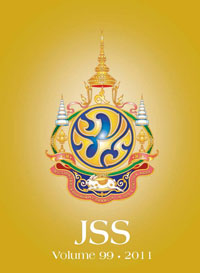Excavation of a Pre-Dvāravatī site at Hor-Ek in ancient Nakhon Pathom
Main Article Content
Abstract
The ancient city of Nakhon Pathom is the largest Dvāravatī moated site in Central Thailand and has been generally dated to about the seventh to eleventh centuries AD. It has been cited as a capital or a cultural centre of the Dvāravatī period. However, most studies of ancient Nakhon Pathom have taken an art-historical approach, such as Pierre Dupont’s seminal work in 1939–1940 and Piriya Krairiksh’s study of Chula Prathon Chedi in 1975. Basic archaeological study of the cultural stratigraphy in the areas of ancient occupation was conducted only in 1981 with the excavations of Phasook Indrawooth. This article presents the results of archaeological excavation of the Hor-Ek site in 2009 that show evidence of human occupation during circa the third to eleventh centuries AD. The new data from Hor-Ek thus extends the occupational sequence back to a Pre- or Proto-Dvāravatī Period.


